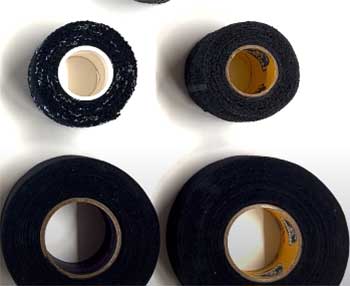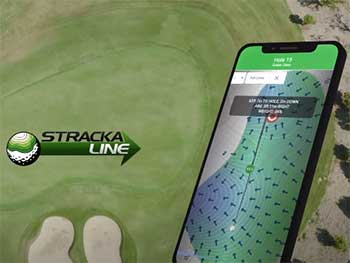Compression socks seem simple on the surface – just tight-fitting socks that improve circulation, right?
Wrong.
Between gradient compression technology, specialized fabric blends, and cushioning configurations there’s so much more to uncover ‘underneath’. Especially when it comes to industry leaders like Comrad and Bombas.
Both brands make excellent products focused on comfort and blood flow promotion to relieve achy, swollen feet and legs. But there are some key differences that may make one better suited for your needs and budget. This comprehensive guide will cover all the nitty gritty details in plain language.
I’ll be drawing from my background as a podiatrist to help break down compression methodology, materials, sizing, and real user reviews. Consider me your feet-loving compression connoisseur! By the end the best choice for YOU will be clear.
We’ll start with a quick snapshot comparison before diving into the functional features and fabrics that set them apart. Let’s kick things off!
At A Glance Comparison
| Aspects | Comrad | Bombas |
| Ideal User | Chronic condition sufferers needing clinical-grade fit and compression | Active folks seeking all-day standing & walking comfort |
| Compression Range | 15-20mmHg, 20-30mmHg | 15-20mmHg, 20-30mmHg |
| Compression Type | Graduated (decreases from ankle up) | Consistent all-over |
| Sock Heights | Calf, Knee High, Thigh High | Ankle, Calf, Knee High |
| Fabric Blend | Nylon & Elastane | Nylon, Merino Wool, & Elastane |
| Cushioning | Light, Moderate, Firm options | Medium Density |
| Sizing | XS-XL in 36 size/compression combos | S-L in standard shoe sizes |
| Price Per Pair | Roughly $30 to $90 | $40 to $120 |
Phew, that’s a lot to digest from some innocuous looking socks!
Now that we have the bird’s eye view covered, let’s dig into the nitty gritty. We’ll tackle Comrad’s clinical approach first.
Comrad Compression Methodology
Comrad was actually founded by a medical wholesaler who saw compression garments being mis-fitted constantly. That meant patients lost out on the blood flow promoting benefits.
They operate on the premise that medical compression MUST fit precisely while applying gradient pressures to work properly. That explains their huge size range – it gives a dialed-in fit unavailable elsewhere.
Graduated Compression

Most importantly, Comrad uses medical-grade graduated compression.
This means the compression LEVEL decreases from the ankle UP towards the knee.
The tightest squeeze around the ankle acts like a pump to actively mobilize blood and fluid back to the heart.
As it reaches the calf and knee areas, compression slowly decreases to aid passive downward blood flow.
Think of strong compression around the ankle lightly ‘hugging’ up the leg.
This gradient methodology is crucial for conditions like:
- Chronic venous insufficiency
- Lymphedema
- Post-surgery swelling
- Blood clots / prevention
- POTS syndrome
- Varicose veins
If you’ve been diagnosed with any leg circulation issue, I ALWAYS recommend graduated compression first line. And Comrad does it extremely well.
They offer both 15-20mmHG for mild issues and 20-30mmHg for moderate circulation support. The latter extra squeeze around the ankle can make a big difference in symptom relief. I often fit patients with combo packs that allow them to test which level feels best.
Precision Fit Comrad’s precision fitted sizing results directly from their medical focus. Rather than generic Small-Large options, their sizing chart uses actual calf circumferences. That means getting your exact measurements translates to a made-to-order like fit.
With options from XS (10 inch calves) up to XL (20 inch calves), they truly accommodate all leg shapes and sizes. This can be a godsend for especially petite or plus-sized individuals who struggle to find well-fitting clinical socks.
While this level of sizing requires extra effort when ordering, it guarantees the graduated compression works properly. Ill-fitting medical compression loses all functional benefits, so this is crucial.
If unsure where you land sizing-wise, Comrad provides printable measuring guides. And their helpful customer service can point you in the right direction as well. Getting the fit dialed in is worth the extra attention.
Bombas Compression Approach
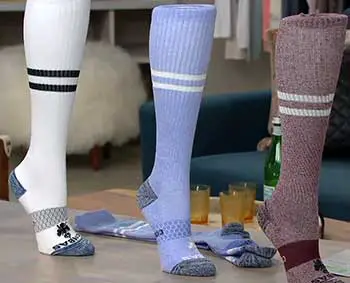
While founded purely for comfort at first, Bombas quickly realized compression’s mass appeal for fatigued feet and legs.
They now offer both mild 15-20mmHg and moderate 20-30mmHg compression socks consistently across their lineup.
But unlike Comrad, Bombas sticks to a one-compression-fits-all approach.
Rather than tight around the ankles and decreasing up-leg, Bombas compression remains CONSISTENT from toes to cuffs.
All-Over Compression Bombas found through extensive user testing that consistent, all-over compression felt most comfortable for all day wear.
By keeping squeezing steady throughout, there are no transition points causing blood flow turbulence. Think of it like a full leg hug rather than a directional anklet-to-knee massage.
This consistent compression style works similarly to support socks for active feet. It aims to fatigue-proof feet and calves so they can keep going and going without tiring out. For those on their feet all day standing or walking, the fatigue relief and energizing feel make Bombas a great choice.
I suggest consistent compression for clients needing mild circulatory support or for preventing issues from developing. Nurses, teachers, retail workers often fall into this category from all the pounding pavement. It provides a gentle leg recharge during downtime.
Simplified Sizing Bombas also keeps things simple sizing-wise offering Small to Large options. This corresponds to standard women’s shoe sizes. While not as customized as Comrad, less guesswork makes it easier to nail down your fit.
And even in the wrong size I find Bombas socks stay put far better than competitors. They seem to cling to your feet giving that true ‘second skin’ feel compression should provide. Choosing a size up or down is often about comfort preferences rather than overall function.
If you know you always wear a women’s size 8.5 shoe, you’d be a Bombas Medium. Easy peasy. No measuring tapes required.
Fabric Faceoff
We’ve covered the key compression differences. Now let’s explore the materials and textures that set Comrad and Bombas socks apart. It comes down to clinical-grade fabrics versus lifestyle-driven blends and design.
Comrad Materials
Nylon and Elastane Construction
You won’t find any cotton in Comrad’s socks! They utilize nylon for its smooth, breathable structure blended with elastane for consistent, long-lasting stretch. This creates durable, woven compression that won’t lose elasticity or shape over time.
Elastane allows the firm ankle graduation to relax just slightly moving up-leg without losing medical-grade pressures. This alleviates any pinching or discomfort at transition points. Pretty nifty!
And the nylon-forward build means Comrad socks tend to withstand daily wear and weekly washing without pilling. Darning isn’t needed! Though I recommend mesh laundry bags to prevent snags just in case.
Variable Cushioning Now to the good stuff (for me at least) – underfoot cushioning! Finding the right balance between cushioning and ground feel responsiveness is an art AND science.
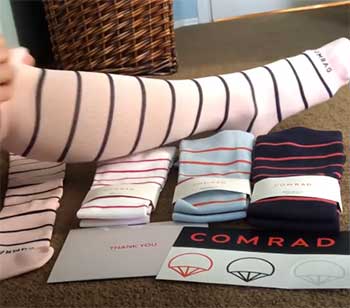
Too much squish dulls proprioception compromising balance and fatigue relief.
Too firm and shock forces reverberate painfully through joints.
So what’s the compression sock sweet spot?
The answer is…variable depending on health needs and preferences!
Thus Comrad gives options:
- Light Cushioning – Thin, breathable pads placing feet closest to the ground for maximum sensory feedback and mobility. Great for yoga, barre, or light walks.
- Moderate Cushioning – Middle thickness for balanced shock absorption and circulation promotion if on your feet often. My top overall choice.
- Firm Cushioning – Maximum plush underfoot protection for hardcore standing athletes or those with chronic foot pain. Supportive yet still stable.
I applaud this degree of customization often missing from medical socks focused solely on gradient pressures. Goldilocks cushion empowers optimal comfort choices.
Bombas Specialized Blend
Merino Wool & Modal Equation Rather than straight nylon, Bombas infuses temperature regulating merino wool plus breathable modal fibers into their fabric foundation. This creates an ultra-soft hand-feel making them enjoyable for pure lounging as well.
The wool-forward blend actively pulls moisture away from the skin for cool, dry feet all day. No more soggy compression! It also prevents odor build-up so you can rewear them between washes guilt-free. I confirm the stink-resistance firsthand.
Medium Cushioning Density Bombas sticks with one unified cushioning approach across all their compression socks. The mid-level medium-density foam aims to suit most preferences and needs out the gate.
The lifted heel and supportive arch cradle feet comfortably whether you’re walking all day or relaxing after work. And the responsive toe spring design allows toes to splay and grip normally during strides.
Overall it provides shock absorbing comfort without feeling overly cloud-like or clunky. While not as customizable as Comrad, this simplified cushioning keeps the socks feeling light as air.
Special Feature Faceoff
Now that we’ve covered the fundamentals, let’s explore some special features that set Comrad and Bombas apart when it comes to comfort, fit, and performance.
Comrad’s Clinically-Inspired Details
Hand-Linked Toes
One of the most common complaints about compression socks? The bulky, irritating toe seams that overlay toes causing blisters and pressure points.
That’s why Comrad hand-links all toe boxes with zero seams crossing over toes. The smooth stitching follows anatomical toe contours for barely-there blister-free wear. Hooray! This extra production effort makes a big difference long term.
Non-Binding Welted Cuffs
Ever had compression socks that squeeze your calves so aggressively they slide down constantly? That compromises the gradient pressures causing the socks to lose all medical function.
Comrad’s non-binding welted cuffs (the tops that hit below knees) use flexible stays that grip calves gently without painful indentations. This prevents sagging while supporting a range of calf shapes and sizes beyond their sizing chart.
If you fall between sizes, opting up and relying on the cuffs prevents sagging issues. Patients rave about the custom-like hold without pinching or migration even after all-day wear. That security brings much needed peace of mind!
Bombas’ Comfort-Focused Upgrades
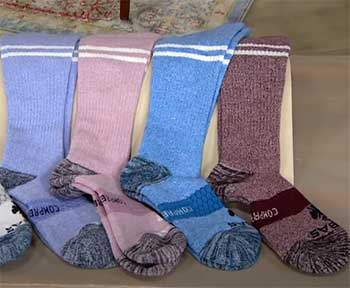
Targeted Arch Support While most compression socks skimp on arch contouring, Bombas integrated legit arch support into every pair.
This prevents feet from collapsing inward reducing pain that radiates up ankles and shins after long hours standing.
The arch hugging shape also brings circulation benefits speeding up recovery.
Compression works best when applied evenly across compressed areas like arches. Bombas really got that important anatomical zone right where others ignore it.
Anti-Slip Cuffs
Nothing ruins compression socks faster than them sliding down your calves leading to ankle bunching and sagging. Bombas practically patented the anti-slip cuff design to combat this issue.
They incorporated silicone grippy strips on the interior cuffs to prevent migration while staying in place. That means the compression keeps hugging legs evenly rather than sliding south.
And unlike skin-digging elastic bands, the anti-slip silicone causes no discomfort even for curvier calf sizes. These cuffs help take the precision fit factor largely out of the equation.
Sizing Showdown
Finding your ideal compression sock size and compression requires trying out a few combo options ideally. It varies so much person to person making generalizations impossible.
But between Comrad’s precision clinical range and Bombas simplified sizing, getting a shortlist narrowed down is totally doable. Here’s how the sizing showdown plays out.
Comrad Sizing Specificity
Without question Comrad offers the widest, most customized compression sock sizing on the market. With 12 sizes from XS to XL and 3 levels of compression, there are 36 size and pressure combinations available. It can feel overwhelming.
But remember – this degree of specificity guarantees the sock gradients and grafting hit anatomical zones properly. That precision ensures the compression socks actually WORK maximizing healthy circulation.
It does take diligence to measure properly and select your starting point.Stretch fabric means erring on the side of smaller over larger in most cases to get the ideal squeeze.
My advice? Choose a mid-range size that corresponds closest with your calf circumference then go up or down a level in future orders if needed. Having multiple compression strengths on-hand helps fine tune as well.
Bombas Streamlined Simplicity
Rather than precise sizing metrics, Bombas sticks to standard US shoe sizing for compression socks. So if you wear a women’s size 8.5 shoe typically, you’d fall under Bombas Medium socks. Easy!
With only 3 sizes from Small to Large available, less guesswork is needed to narrow things down fast. And the anti-slip cuffs allow for a little size wiggle room without negatively impacting functionality.
Choosing your typical shoe size means Bombas socks default to mildly snug. The material blends stretch comfortably from there contouring most calf and ankle shapes uniformly. Less compression specificity makes sense for their consistent all-over squeeze approach.
I suggest choosing based on your NON-swollen foot size whatever that may be. Edema and chronic inflammation can distort true foot dimensions. Think back to pre-injury or younger years if unsure. swelling subsides.
Also Read: Comparison of Balega And Feetures Running Socks.
Frequently Asked Compression Sock Questions (FAQ)
Let’s wrap up with answers to some of the most common questions patients hit me with regarding compression gear. Consider it a handy compression primer!
Compression socks effectively help circulation issues ranging from mild fatigue and swelling to chronic venous insufficiency. Common diagnoses they benefit include: Edema (fluid retention & swelling), Blood clots, Varicose veins, Achilles tendonitis, Shin splints, Venous reflux disease, Chronic fatigue syndrome, Diabetic neuropathy, Congestive heart failure, Orthostatic hypotension / POTS syndrome.
Of course compression intensity and fit matches the severity of each condition. But gradient pressure socks make a difference across the board.
The ideal compression sock fit applies gentle pressure without causing pain, numbness, tingling or restricted range of motion. Expect an overall squeezing sensation wrapping feet and calves snugly – but no sharp pinching at seams or band edges.
If things start going numb or sore spots develop, compression is too intense. Size up or decrease the pressure grade. Some adjusting periods are normal but pain signals sizing issues.
Compression socks help circulation best when worn throughout high activity periods where legs experience fatigue and swelling. Then keep them on during recovery periods elevating legs above heart level when possible.
Consistently wearing them daily proactively prevents damage long term. I suggest cleaning at end of day then slipping into a fresh pair each morning. Rotate pairs to maximize product longevity as well.
Remove debris then hand wash or machine wash gentle cycle in cold water with mild soap. Never bleach or iron! Lay socks flat or line dry only to prevent damaging elasticity from heat Tools like mesh laundry bags add protection from snags in machines.
And there you have it – the full compression sock shebang from material construction to washing care! Let me know any other questions in your personal quest for happy feet and legs.
The Final Verdict
We’ve covered a ton of nitty-gritty details differentiating Comrad and Bombas compression socks. But which brand should you actually purchase? Here’s my professional podiatrist verdict.
For clinically diagnosed circulation issues requiring gradient compression – Comrad comes out ahead. Their emphasis on precise, graduated compression aligned with medical standards makes them hard to beat functionality-wise.
Getting the sizing and preferred compression dialed in takes a bit more effort upfront. But once you find your fit sweet spot, Comrad socks deliver proven circulation and edema relief. Well worth the extra attention.
For mild compression use or all day standing comfort, stick with Bombas. Their simplified sizing and ultra-comfortable seamless construction ensures all day relief staying in place. I constantly recommend Bombas to nurses and teachers logging ridiculous daily steps but not struggling with diagnosable medical issues.
Prioritizing premium materials and smart design gives Bombas the upper hand for pure comfort and lifestyle enhancement purposes. And the brand recognition means you can share your awesome socks when people ask!
Both brands offer 30 day trial periods to take compression socks for a test walk. Ideally try both for yourself and see what compression style works and feels best. There’s no universal right choice – personal needs and preferences decide what brings YOUR legs the most love.
